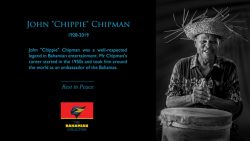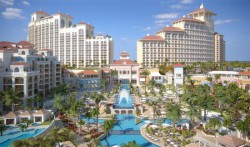Mr. Neal Sealey, publisher, founder and Editor of The Bahama Journal of Science is a partner in Media Enterprises Ltd., and has also published over a dozen major publications and articles that include Bahamian Landscapes, An Introduction to the Geography of The Bahamas; The Bahamas Today; Human and Economic Geography of The Bahamas; The Bahamas Environmental Handbook among others. Mr. Sealey was a recent guest on Contact. Contact is hosted by Mike Smith.
Mr. Mike Smith: Some people on Guana Cay may be a bit nervous because of what has happened there before, and what I mean by that is Disney operation used a portion of Guana Cay to berth their cruise ships and bring them in so that people could use the wonderful beaches there, but as a result they had to dredge a significant channel, they had a spill island left over and the environment is not pristine in that particular area anymore.
Mr. Neal Sealey: No. This is quite true, thatᄡs the northern part of the bay facing south. Iᄡm not sure that Disney should be blamed for that. I call it the Disney operation because everyone else does, but I believe the development was by someone else and it was Disney boats that actually used it under a form of a sub-contract. If you walk through that area, in fact, from the moment you actually enter the bay you will see the dilapidated dock area for the large tenders; that would be renovated using existing piles. That will exist but in a smaller form because there is no other place to land in that area at the moment and the rest of that area will be restored. Iᄡve walked through that area, thereᄡs old machinery laying around, there are old wooden structures, fortunately they are wooden, there are not many concrete structures, but as happens in The Bahamas, anywhere where you remove the natural vegetation you tend to get invasives and particularly on the coast you get the casuarinas, which is very aggressive and very destructive to native vegetation. That whole area will be cleared and restored using existing vegetation on the island from areas that havenᄡt been infected, so thatᄡs one part of it which is suddenly a big plus, but also where the marina is, I understand is going to be restitution or what they call mitigation for anything that they destroy they will revive somewhere else and there are sections that have been damaged all around the island and for a variety of reasons it would take too long for us to look at all of them.
Mr. Smith: Has there been any damage ヨ to your knowledge ヨ from the dredging that was done to accommodate the Disney craft on the reefs and the mangroves? Has there been any environmental damage?
Mr. Sealey: I canᄡt truthfully answer that. Obviously a very large channel was dug and of course they dug up the seabed ヨ I did see some of the spoil, which Mr. Larson from the National Trust showed me at one time, and he was discussing that with me, and it seems to be just a normal sandy seabed that you get in The Bahamas. But they had a huge turning base and the size of the spoil small island itself would give you some idea of the amount of material taken out.
Mr. Smith: Its substantial isnᄡt it ヨ the spoil island?
Mr. Sealey: Yes. The spoil island isnᄡt included in the development, because it was created and wasnᄡt in existence before. This isnᄡt going to be touched, but to answer your question from my knowledge of similar dredging, there must have been silt damage to the reefs, which if they didnᄡt destroy them would certainly have inhibited their growth for a period of time; and any other vegetation in the environment or any animal life in the area, and of course that particular dredged channel is now a different environment, it is not a shallow water bank and it also allows swells to enter into the bay where they previously didnᄡt have a deep water access into the bay, so the actual movement of water is going to be different. So the environment has been changed. So yes there has been an impact, and we have to live with that.
Mr. Smith: As we move forward now, there seems to be tremendous interest in The Bahamas, obviously we know why ヨ weᄡve got beautiful islands, beautiful environment, lovely protected areas ヨ and it seems as though our country is hot for developers now. How careful do we have to be as we move ahead with over-development of these areas, safeguarding these areas and managing these areas?
Mr. Sealey: Enforcement is really the crux of the matter here. I remember attending tourism meetings 15 years ago and people in the audience were saying, well why donᄡt we do this, and the ministerial representative was saying, well we have a law for this and we have a law for that, which is perfectly true and if you look at it, weᄡve got laws to cover just about everything, they are not enforced, nobody does anything. People dig out hills, and after the events someone is going to get sued, maybe ヨ all sort of things are happening in Bimini, Exuma, on the Cays in the Exumas ヨ people are just running amok. There is bad marina developments in South Bimini and in Sal Salvador that Iᄡve personally observed, where they just cut straight into the coast, which is absolutely forbidden in any regulated country and there is no way that we can get away with it. If you do that down in the Florida Cays, apart from going to jail, you are going to pay for rebuilding the coast back to the way it was. And I know for a fact that this has actually happened in Florida, where people have made that kind of indentation. But people will move in without EIAs or anything and damage the coast. I would say that the first level of awareness is that people have not got to be fobbed off with promise of employment and jobs etc. and let the bulldozers and dredgers come in and rip up a piece of the country, thatᄡs number one, there has got to be an outcry about this from the very beginning. The second thing is that these developers have to be monitored through ヨ if its going to be BEST, fine ヨ an EIA system and it has to be properly enforced. I suspect BEST at the moment is a bit overwhelmed and undermanned both in quantitatively and qualitatively to deal with the vast array of developments which are proposed. Never mind in The Bahamas, how many people in the world are experts on LNG terminals? And frankly how many people are experts on Bahamian water table and water lenses?
Mr. Smith: What worries me so much is in hindsight ヨ I grew up in Marsh Harbour ヨ and there was a tremendous wetland near by what is now the major port dock and then beyond that a road divided it. When the harbour was dredged to allow larger boats to use the docks, they put the silt in the wetland, and of course that is what created the famous Mudd, that we hear about nowadays with all the problems with the illegal immigrants. But, I now could envision a wetland in there with literally cafes around it, natural tours in there kayaking, canoeing and that would form the literal center of March Harbour per se, and all of the business district would be around it. But it is too late. How do we stop that level of short sightedness and destruction from this point on?
Mr. Sealey: One area you are going to have to deal with very quickly is the new port for New Providence, obviously we have a very difficult situation now were weᄡve got a pristine tourist environment at the harbour which is a beautiful harbour in the Caribbean used up by commercial docks and container vessels, and the pollution they bring, nevertheless, you can still see the bottom of the harbour from the dock side, but we need a new harbour and its got to go somewhere on this island. How are we going to deal with that? I would say that that is a challenge for anyone, its not like Guana Cay ヨ lets stop this development and have nothing. This is not an option here.
Mr. Smith: We have got to make a decision.
Mr. Sealey: Yes. Weᄡve got Arawak Cay, which is partly a port, and is probably a much bigger port than much people realizes if you look at the tonnage that is landed there these days, and it has the advantage of deep water access. We also have Clifton Cay, which is an even deeper water port at the other end of the island. I donᄡt know if I can answer your question, other than what I have said before obviously we donᄡt want to dig out swamps, we donᄡt want to dig out Bonefish Pond or Millerᄡs Pond or anything like that and any proposal that does it should be subject to a proper investigation, whether its an EIA, which tends to be focused on foreign developers. I donᄡt know that EIAs are actually legally required or that BEST is going to require them for Heads of Agreement for local development, and of course Marsh Harbour would have been a local development and also at some time in the past ヨ in the 60s ヨ and of course a lot of wetland has gone. The critical thing now is the wetland in Bimini. That wetland is not only an active bonefish area and an attraction to many people for a variety of reasons like shark breeding and research, but has a lot of international publicity from National Geographic down; and you know National Geographic is a serious entity. We really donᄡt want people like them saying that we are messing up our own environment. In the case of Bimini, very little is being done, they keep renewing and re-agreeing development, but if you look there from an aerial view it shows quite clearly all sorts of degradation to the environment, thatᄡs what we want to try and avoid. And in the case of Bimini that area of wetland and marsh mangroves on north Bimini is the only wetland area in that area of The Bahamas, youᄡve got to go to Grand Bahama or Andros. So this is like a little pocket for breeding a nursery of shellfish and fish and being a mangrove environment in its own right.



